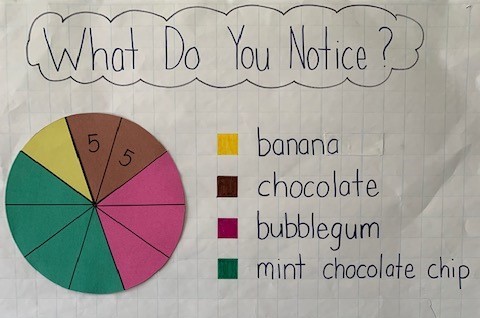
What Do You Notice? Pie Graph
There’s been a big push to get students looking at and analyzing data. So I’m excited to share with you one of my latest What Do You Notice? posters…a poster that gives students (and their families) an opportunity to think about and share their thoughts about the math they see.
For this poster, I created a simple pie graph as a fun way to show students how information can be visually organized. That said, as you’ll see in the description below, there’s a lot more going on in this “simple” graph.
The first thing most students will notice is that the poster has something to do with…pies? ice-cream? flavors? I deliberately left off a title so they could come up with an idea of what they think the graph represented. We’re not always given all the information and this is good thinking practice.
Then young students will probably notice that the graph is in the shape of a circle which is divided up into sections. They can notice that each section is equal in size and might even say that the sections look like triangles.
They can count the number of sections (10) and notice there are two number 5s and may even add them to get 10. Since students can see that each equal section is equal to 5, older students can determine the value of each of the flavors.
This graph also introduces them to legends where they can match the flavors listed in the legend to the sections on the pie graph.
When analyzing the data, they’ll notice that banana has the least and mint chocolate chip has the most. In what ways would this information be useful? This may not come up at your Family Math Night event, but it’s a great question to ask in the classroom.
Intermediate students can determine that if each section is equal to 5, then the entire graph represents a total of 50. Super savvy students, with the help of their parent, may figure out that if they double each section so that they equal 10, then the entire graph equals 100. From here they can determine the percentage of each flavor.
These students can also notice fractions. If each section represents one tenth of the entire circle, they can determine the fractional value of each flavor.
At an even higher level, these older students may notice that the angle measurement of each section is equal to 36 degrees (360 degrees divided by 10 sections = 36 degrees/section). From here they can determine the angle measurement of each of the colored sections.
So clearly there is a lot going on in this simple graph. And what’s great about these What Do You Notice? posters is that students of all ages can notice something math related.
If you like this poster, we have a lot more! Click here to check them out. You’ll also be able to read real comments about this latest poster from students at my recent Nifty Numbers Family Math Night event.